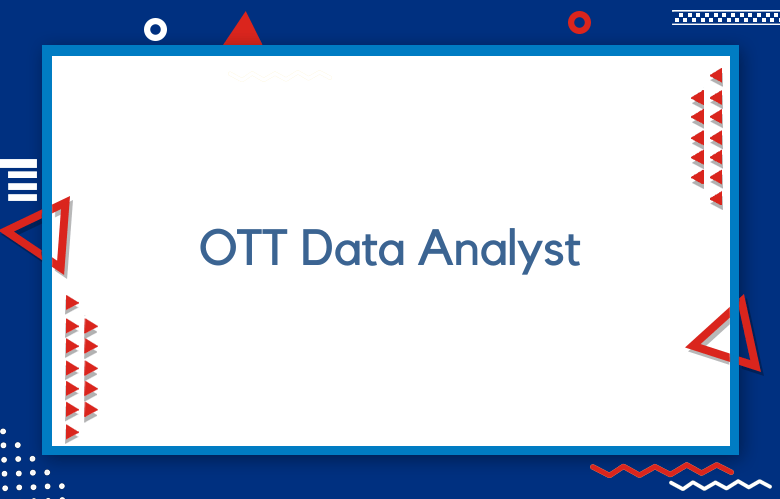How to become an OTT Data Analyst

With the rise of over-the-top (OTT) media platforms, the demand for data analysts to interpret and analyze audience behavior has increased substantially.
As more and more companies adopt OTT strategies to stay competitive, there is a growing need for skilled analysts who can help them make sense of the data. If you want to become an OTT data analyst, you have come to the right place. This blog will give practical tips to help you launch your career in this exciting field.
How to become an OTT Data Analyst
Develop your quantitative skills:
To become an OTT data analyst, you must have a strong foundation in mathematics, statistics, and computer science. You must also be able to work with large data sets and use statistical tools to derive insights. Enrolling in a bachelor’s or master’s degree program in one of these fields is an excellent start.
But even if you already have a degree in another field, you can still learn the necessary skills by taking online courses or attending workshops. Tools like Excel, SQL, Python, or R are essential to analyze data in today’s job market.
Gain relevant work experience:
Hands-on experience working with data sets is essential to becoming an OTT data analyst. Look for internships, entry-level positions, or volunteer work that will allow you to put your analytical skills into practice. This will also allow you to build relationships with colleagues who can endorse you to other professionals in the field. Start with a few projects that showcase your skills and add them to your resume or LinkedIn portfolio.
Keep up with industry trends and innovations:
To stay relevant and competitive in the OTT data analyst field, you must stay up-to-date with the latest tools and techniques used in the industry. You need to subscribe to social media accounts and podcasts that produce content outlining new trends and innovative strategies.
By understanding emerging trends, you can better position yourself for success. Research and experiment with new technologies to apply specific skills to real-life problems.
Network with industry professionals:
Networking with professionals in your industry is one of the most effective ways to advance your career. Join social media groups, attend conferences, and attend webinars hosted by professionals in your field.
This will allow you to learn about industry trends and connect with potential mentors and colleagues. Remember that networking does not have to be done in person. Technology has made it easier to reach professionals from all over the world.
Continue learning:
To succeed as an OTT data analyst, you must be willing to keep learning and growing. Technology and industry trends are continuously evolving, and you must be willing to adapt and improve your skills. You can take advanced courses, read books, learn from mentors, or even consider getting additional certifications. Employers want to hire people who can grow with the company, so your continuing education can be invaluable for your career.
Mastering the Art of OTT Data Analysis
As the over-the-top (OTT) industry continues to gain momentum, businesses are increasingly looking to maximize their returns on investment through data analysis. The ability to effectively analyze OTT data has become a critical factor in determining a business’s success in this competitive industry.
OTT services, such as Netflix, Hulu, and Amazon Prime Video, offer viewers a wide range of programming options, including movies, TV shows, and original content. These platforms collect vast amounts of data on user engagement, including what content is viewed, how long it is watched, and when it is watched.
A Beginner’s Guide to Becoming an OTT Data Analyst
Over-the-top (OTT) services have revolutionized the entertainment industry by offering users convenient and personalized streaming experiences. However, behind the scenes, a highly sophisticated and complex data analysis process allows these services to innovate and improve constantly.
If you are interested in becoming an OTT data analyst, there are a few essential skills and knowledge areas that you should strive to develop. First and foremost, you should have a solid understanding of statistics, data analysis methodologies, and programming languages such as Python or R. These tools will allow you to clean and manipulate large datasets, identify patterns and trends, and create predictive models that can inform business decisions.
Essential Skills for OTT Data Analysts
Data Analysis
Data analysis is a fundamental skill for OTT (over-the-top) data analysts. This involves collecting, organizing, and interpreting large data sets to identify patterns and trends. OTT data analysts must be proficient in using various tools and techniques such as SQL, Python, or R to analyze data effectively.
Knowledge of OTT Platforms
OTT data analysts should understand the different OTT platforms, such as Netflix, Hulu, and Amazon Prime Video. This includes knowledge of their user base, content offerings, and business models. Understanding the differences between these platforms can help analysts make more informed decisions when analyzing data.
Statistical Analysis
In addition to fundamental data analysis skills, OTT data analysts should have a solid foundation in statistical analysis. This involves using statistical methods and models to draw insights from data and make predictions. A strong understanding of statistics is crucial for accurately interpreting complex data sets.
Data Visualization
Communicating insights from data effectively is a crucial skill for OTT data analysts. This requires knowledge of various visualization tools and techniques such as Tableau or Power BI. Visualizing data in charts, graphs, and dashboards can help stakeholders understand complex information more easily.
Programming Skills
While not all OTT data analysts need to be expert programmers, having some programming skills can significantly enhance their abilities in analyzing large datasets. Familiarity with languages like SQL or Python can allow analysts to manipulate and query databases more efficiently.
Business Acumen
OTT data analysts must also possess business acumen to understand how their analyses impact the company’s goals. They should be able to translate technical findings into actionable insights that align with business objectives.
Attention to Detail
As OTT platforms continue to grow and evolve rapidly, data analysts must have a keen eye for detail. This involves meticulous data collection, analysis, and reporting to ensure accuracy and avoid errors.
Time Management
OTT data analysts often have multiple projects and deadlines, so strong time management skills are essential. They must prioritize tasks, meet deadlines, and effectively balance their workload.
Communication Skills
Effective communication is vital for OTT data analysts, who often work with cross-functional teams and must present complex data to non-technical stakeholders. They should be able to clearly explain their findings and recommendations in a way that is easy for others to understand.
Continuous Learning
OTT data analysts must be committed to continuous learning and staying updated on industry trends and technological advancements. This allows them to adapt quickly to industry changes and continue providing valuable insights for their organizations.
Demystifying OTT Data Analysis: A Step-by-Step Approach
Understand the Basics of OTT Data Analysis
Before diving into OTT data analysis, it’s essential to have a solid understanding of what it is and how it works. OTT (Over-The-Top) refers to streaming media services delivered directly to online viewers, bypassing traditional cable or satellite providers.
This includes platforms like Netflix, Hulu, and Amazon Prime Video. OTT data analysis involves collecting and analyzing data from these streaming services to gain insights into viewer behavior.
Define Your Objectives
The first step in any data analysis project is clearly defining your objectives. What do you hope to achieve by analyzing OTT data? Are you looking to improve user engagement, increase subscriptions, or better understand your target audience? Clearly defining your goals will help guide your analysis and ensure that you focus on the most relevant data.
Choose the Right Tools
Many tools are available for analyzing OTT data, so choosing the ones that best fit your needs and objectives is essential. Some popular options include Google Analytics, Adobe Analytics, and Conviva. These tools can help you track viewing time, device usage, and content popularity metrics.
Collect Data from Multiple Sources
To get a comprehensive understanding of viewer behavior on OTT platforms, it’s essential to collect data from multiple sources. This includes your platform and third-party sources such as social media and market research reports.
Clean and Organize Your Data
Before diving into analysis, cleaning and organizing your data is crucial. This involves removing duplicate or irrelevant information and consistently formatting all data. Having clean and organized data will make the analysis process much smoother.
Identify Key Metrics
Once your data is cleaned and organized, it’s time to identify key metrics that align with your objectives. These could include average viewing time, subscription rates, or user retention. Focusing on these critical metrics lets you gain valuable insights into viewer behavior and make data-driven decisions.
Analyze and Visualize Data
Considering your critical metrics, it’s time to analyze your data and look for patterns or trends. This could involve creating charts, graphs, or other visualizations to help you better understand the data. These visualizations can also be helpful when presenting your findings to others.
Compare Data Over Time
Comparing data over time is essential to truly understanding how your OTT platform is performing. This will allow you to see seasonal trends or if specific changes have impacted viewer behavior.
Draw Conclusions and Make Recommendations
After analyzing the data, you must conclude and make recommendations based on your findings. This could include suggestions for improving user engagement or increasing subscriptions based on the insights gained from the data analysis.
Continuously Monitor and Adjust
OTT data analysis is ongoing, so monitoring and adjusting your approach as needed is essential. As viewer behavior and technology evolve, so should your data analysis strategy to stay ahead of the curve and make informed decisions for your OTT platform.
From Novice to Pro: Unlocking the Secrets of OTT Data Analysis
Over the past decade, streaming services have transformed the entertainment industry, becoming a significant player in shaping the content consumers see and how they view it.
The rise of Over-the-Top (OTT) platforms has created an enormous amount of data for industry professionals to mine, interpret, and make informed decisions from. Data analysis and interpretation are essential factors in the success of any media business, especially OTT.
OTT data analysis can offer critical insights into consumer behavior, preferences, and viewing habits. By analyzing OTT data, media companies can make data-driven decisions to improve their content offerings, identify emerging trends, and capitalize on new opportunities in the market. Whether it’s measuring which shows are most popular or which types of advertisements are resonating with viewers, data analysis provides an essential foundation for success.
Conclusion:
Becoming an OTT data analyst can be a challenging but rewarding journey. The demand for skilled data analysts continuously grows, creating new opportunities for those passionate about the field. You can start your career path as an OTT data analyst by acquiring quantitative skills, gaining relevant work experience, keeping up with industry trends, networking with professionals, and continuing learning. Stay curious, stay analytical, and remain passionate.
Call: +91 9848321284
Email: [email protected]



